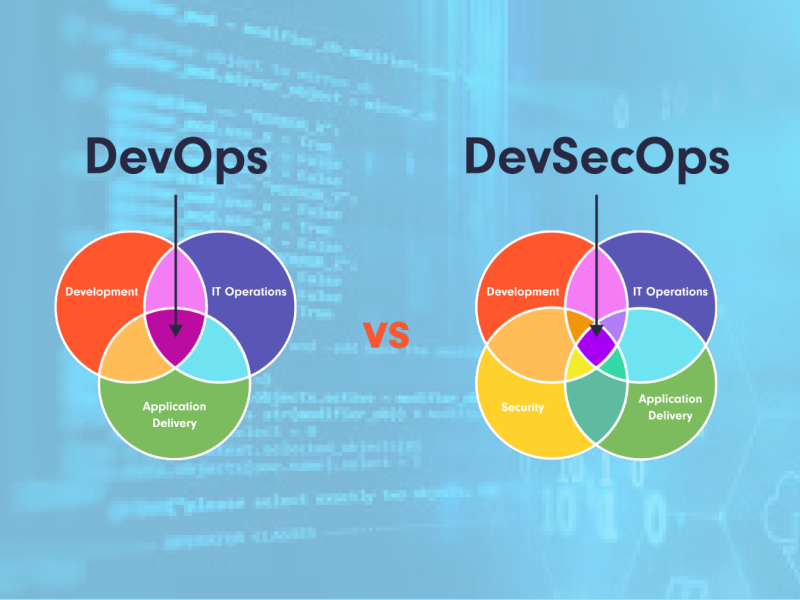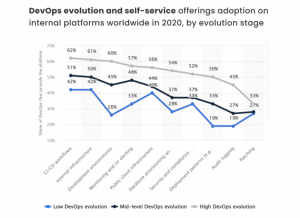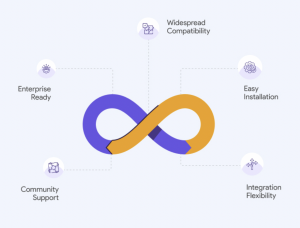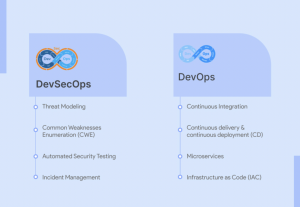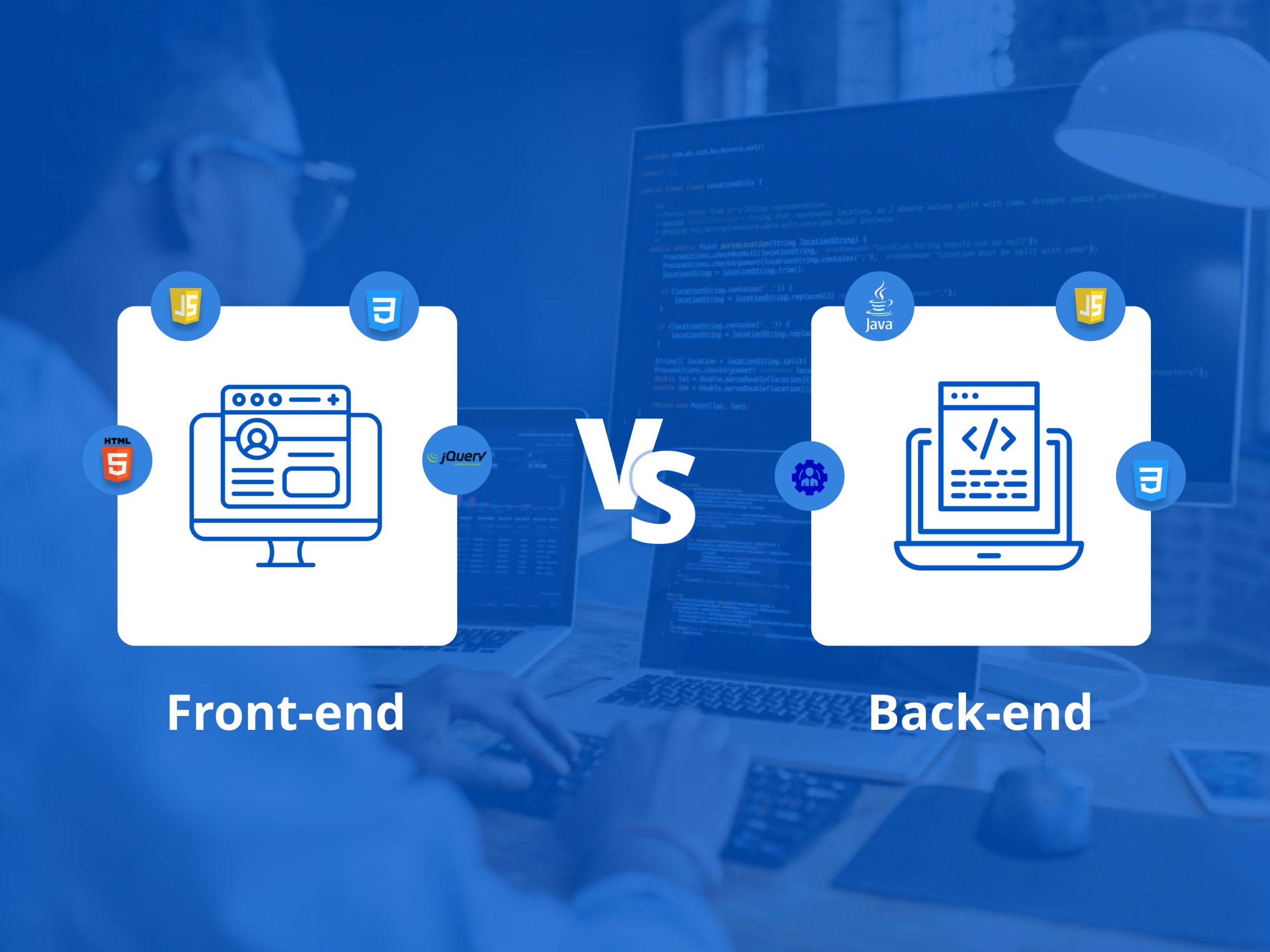The DevSecOps vs. DevOps debate has been one of the most hotly contested battles in today’s software development, security, and infrastructure communities. While both approaches have some strong aspects, ultimately, it comes down to your preferences and needs.
DevOps is undoubtedly more popular and practiced widely in the IT industry. In fact, as per Statista, DevOps adoption is encouraged in diverse industry verticals.
On the other hand, DevSecOps is a less popular term, and many beginners fail to recognize the time. However, DevSecOps is not a new way of software development.
For organizations concerned about security, understand DevSecOps before diving in. The goal of DevSecOps, a term coined by HPE, involves delivering faster product releases with increased stability and ensuring that users can do their jobs securely. It is the integration of the security approaches into the DevOps Methodology.
Think of it as continuous integration applied to security processes. DevSecOps combines security testing into a workflow process (including automating updates) that already exists in today’s software development methodologies. An accurate understanding of DevSecOps requires an acceptance of digital transformation across all levels of business, from start-ups to established corporations.
This article will compare both approaches and help you decide which one works best for your organization. The infographic below highlights their differences.
Table of Contents
DevSecOps vs. DevOps – Comparison
Let’s explore the differences in detail:
DevSecOps vs. DevOps – The Difference in Collaboration
DevOps is a methodology that focuses on collaboration among software developers and IT operations professionals. DevSecOps ensures the same with more emphasis on security. It is a newer approach that brings security into mainstream IT operations.
To be successful, DevOps must have a spirit of teamwork to create quick releases, and the same goes for security operations, as multiple different skill sets are required. The notable ones include configuration, policy, monitoring, and compliance — to maintain software security.
According to the traditionally practiced DevOps approach, security concerns get dealt with late in the development process. Sometimes, it leads to missed vulnerabilities or untested code.
On the other hand, for DevSecOps to be effective, there must be a concerted effort to allow collaboration and integration of developers and security professionals to collaborate and integrate throughout the development process. As per DevSecOps, teams have to break free of their specialty and collaborate across different fields to make breakthroughs.
As different as these two approaches are, they ultimately share a common goal — developing secure software products that customers want to use.
Some security experts favor traditional methods for ensuring application security over newer approaches such as DevSecOps. However, most DevOps development companies believe that organizations need to invest in both to be truly successful.
DevSecOps vs. DevOps – How Do They Leverage Automation?
Automation improves productivity by reducing human error. However, without proper checks, automation can bring chaos into an environment if there isn’t a strategy that ensures quality assurance processes or builds trust among developers and IT teams. While both technologies streamline development and operations, each has a different approach to implementing practices to speed up software development.
DevOps leverage automation for deployment, monitoring, scaling, configuration management, etc. However, without proper security measures to protect data, it’s easy to see how a lack of control can lead to data breaches. It’s also important to note that with either technology, there are many different ways to implement them – so it’s essential to choose a strategy that works best for your organization.
The goal of DevSecOps is to achieve security through continuous monitoring of production environments. It automates security tasks such as checking configurations to ensure shorter development time. In contrast, DevSecOps combines manual security testing with automation to ensure that systems are secure before deployment.
However, it’s important to note that while programmers of a DevOps development company may automate some tasks, not all of them will be automated. For example, some jobs still require human involvement, such as reviewing logs or performing penetration tests on production environments.
DevSecOps vs. DevOps – What Are The Standard Practices Involved?
DevOps caters to various automating software build, test, deployment, and monitoring processes. The notable ones include the following:
Continuous Integration: The objective of CI is to have developers integrate code into a shared repository several times a day. Each check-in then gets verified by an automated build, allowing teams to detect problems early. It enables small changes to be done with confidence and facilitates continuous testing.
Continuous delivery & continuous deployment (CD): CD is a straight extension of CI. It automates all stages of software delivery, allowing teams to get code out quickly. It means that coders can deploy code changes to production without human intervention. CD aims to reduce risk by allowing developers to detect problems early while providing faster feedback on how changes impact systems. It also makes it easier to identify what’s changed to roll back if necessary.
Microservices: A microservice-based architecture allows teams to build and deploy small services, each running its process & communicating with lightweight mechanisms such as an HTTP resource API. This approach increases system resilience through redundancy and enables greater scalability by allowing more fine-grained control over resource usage.
Infrastructure as Code (IAC): IAC enables teams to automate infrastructure provisioning, configuration management, and application deployment. It allows DevOps development companies to treat infrastructure as code, making it easier to manage complex environments. It also means that organizations can scale up their resources quickly by automating deployments. In addition, IAC helps organizations move faster by eliminating manual steps from the deployment process.
DevSecOps aims to fix inefficiencies caused by siloed systems (caused by multiple teams with different priorities). It ranges from ad-hoc reporting on breaches of privacy or data protection rules to breaking down legal barriers that prevent organizations from sharing information about attack threats.
The focus remains on compliance, security, and quality assurance processes. In simple words, it achieves all of it by adding the following to the DevOps practices:
Common Weaknesses Enumeration (CWE): The first step in any security process should be identifying all of an organization’s vulnerabilities. Developers can do this through various methods, but it’s important to note that finding vulnerabilities doesn’t mean fixing them. It has a tremendous impact on code quality and improves the degree of security at CI and CD. Once identified, however, developers need to assign a severity level to each exposure.
Threat Modeling: Once an application has been built, it’s essential to understand how hackers can attack it. This step involves identifying every possible threat that could compromise an application. It’s also important to consider any vulnerabilities in third-party software or services an application uses. Testing for security flaws occurs at every stage of the software development pipeline to ensure that it saves time and money. Threat modeling helps teams think about security from a holistic perspective rather than just from a technical perspective.
Automated Security Testing: This stage involves using various tools to identify potential vulnerabilities in an application. In simple words, it performs a security test on new builds regularly. The goal here is to use as many automated tests as possible because it’s not feasible to run all of these tests manually.
Incident Management: This stage involves responding to security incidents, such as a breach or data loss. There are many different ways to manage incidents, but it’s essential to have a process that includes incident response planning. In this manner, the development team holds a frame of reference for their response to incidents.
So that was all about the differences between these two software development strategies. While both are effective, DevSecOps is an updated form of DevOps.
When Should You Switch From DevOps to DevSecOps?
Though DevOps has proven to be a valuable practice within many organizations, it’s not free of faults. The limitations of traditional processes are so severe that it forces most practitioners to augment their existing techniques with additional tools and security measures to ensure they’re keeping up with attacks.
Often, these organizations deploy Web Application Firewalls (WAFs) and other security tools that can already be achieved through automation. But these aren’t enough. Why? Because no matter the series of attempts you make to automate all of your application-security needs, human factors will always play a critical role in any defensive posture. Thus the answer in such circumstances is DevSecOps.
The goal of DevSecOps is to automate application security checks during all stages of software development. Developers ideally perform such checks without burdening their efforts. It includes integrating security into existing development workflows instead of adding more layers and complexity to an already crowded process.
How to Implement DevSecOps on your Project?
Step1: Educate the team about the transition
Ensure that all team members understand what DevSecOps means, how it differs from DevOps, and why it’s essential. If you’re looking to implement a shift to a DevSecOps environment, ensure that your development team understands the best security practices.
Significant aspects of learning about the transition process
- Educate the team on encryption, authentication, authorization services like OAuth or SAML 2.0, logging options including application performance management (APM) solutions, service monitoring solutions, and anti-virus software solutions.
- It might also be helpful if the team gains exposure to secure coding standards like secure code analysis software tooling like Findbugs or Flawfinde. You should incorporate these into existing development methodologies.
Make sure your DevSecOps teams are on board before changing your current company-wide or project-specific processes. Consult them first on how to roll out DevSecOps, what it would entail, and what benefits the team can expect.
Step2: Choose A Reliable Combination Of Security Testing Methods
It’s essential to ensure a full testing suite because it will cover every application angle. The ultimate goal of security testing is to protect against vulnerabilities and identify existing problems so you can fix them before they change into real threats.
Some of the standard testing processes you can leverage,
- Static application security testing (SAST) can help find shortcomings in your code.
- Dynamic application security testing (DAST) takes a hacker’s perspective, which helps administrators find security gaps and vulnerabilities.
- RASP is an anti-malware solution that responds in real-time to detect and combat cyber-attacks without human intervention.
An interactive application security testing includes SAST and DAST that analyzes the software and uses instruments like simulation, authentication, and injection to monitor its performance.
Step3: Establish High Coding Standards
One way to prepare for breaches is to establish good coding standards for all new team members and anyone else who can change the code. That way, security breaches are less likely to occur in the future.
Once you have the plan, it’s time to educate everyone on what they need to do. This step creates an environment where developers need to use secure coding practices. You can do several things here, but make sure everyone knows how critical security is.
Encourage developers to use tools like Findbugs or Flawfinder to find common mistakes in Java code. If you’re working with Python, consider using PyLint or Pylint 2 to identify vulnerabilities in Python applications.
Step4: Secure Apps in Diverse Aspects
Encourage developers to take a hacker’s perspective when creating new applications. The goal here is to assume that malicious hackers are always trying to find ways in, so all developers should constantly be on guard for potential vulnerabilities.
Protect the network applications running on distributed infrastructures rather than from the perimeter from the inside out. Doing so reduces the time and stress on IT departments and enhances your security.
Read Also: DevOps in Mobile App Development: Is it Worth the Hype?
DevSecOps vs. DevOps – Choose Responsibly
It’s clear why businesses can benefit from both methods. It’s important to understand that these two methodologies aren’t mutually exclusive; they are simply two sides of a coin that must be used together to achieve optimal results.
By combining both methodologies into a unified strategy, organizations will be able to build products faster while also ensuring their security. A well-defined process will allow business leaders to ensure high productivity while mitigating risk.
While DevOps helps build software faster by combining QA processes with development DevSecOps offers an additional layer of security. The goal of DevSecOps is to ensure developers are building secure code from day one, ultimately helping organizations mitigate threats faster.
DevSecOps helps prevent data breaches by improving security controls at every stage of development. However, both philosophies bring value to businesses. An efficient DevOps Services company can help you choose the best option for your needs.
FAQs
Question: Are DevSecOps and DevOps the same?
Answer: The simple answer to that question, according to some experts, is a resounding no. Though both terms are often used interchangeably, they are two very different concepts.
While it’s true that both words do ultimately mean an increase in IT security monitoring within an enterprise, there are quite a few differences that have led some to believe that each term describes something entirely different.
DevOps focuses on automating tasks within a business, whereas DevSecOps focuses on security.
Question: Which technology is best for DevOps?
Answer: DevOps heavily relies on containerization, which improves the efficiency of application development and deployment. Container platforms such as Docker and Kubernetes offer vital qualities such as automation, security, and governance and various capabilities such as orchestration.
Question: Is DevSecOps an add-on to DevOps?
Answer: This has been a hotly debated topic in security circles. Some argue that DevSecOps should exist independently, distinct from regular DevOps. Some experts say that these two practices are inherently incompatible and, when implemented together, create an overly complex environment that’s rife with inefficiencies.
However, you cannot deny that DevSecOps acts as an extension of the DevOps Methodology as a part of a Security Development Lifecycle (SDL) approach. It is because security teams can use it to monitor changes to applications being developed by DevOps teams. As mentioned earlier, these two methodologies are not mutually exclusive; they can work together very well. The key here is a collaboration among all stakeholders involved.

